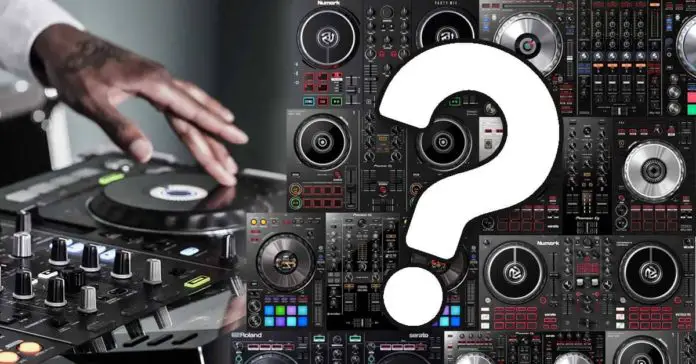Choosing your first DJ controller might not be as easy as it may seem. Budget, skills and future plans are only a few factors that can influence your choice and final decision. The purpose of this guide is to help you choose your first Pioneer DJ controller and begin your DJing journey as fast as possible!
- Entry-level DJ controllers vs. “Professional” DJ controllers.
- Pioneer DDJ-FLX4 – One of the best choices in 2023
- Pioneer DDJ-Rev1 – A good choice for Serato DJ users?
- DDJ-SR2 – A small SX-like powerhouse
- 2 channels vs. 4 channels debate
- Moving towards more advanced gear
- Pioneer DDJ-1000 – the flagship
- Pioneer DDJ-SX3 – the Serato beast
- Last things last
This web portal is reader-supported, and is a part of the Amazon Services LLC Associates Program and the eBay Partner Network. When you buy using links on our site, we may earn an affiliate commission!
Entry-level DJ controllers vs. “Professional” DJ controllers.
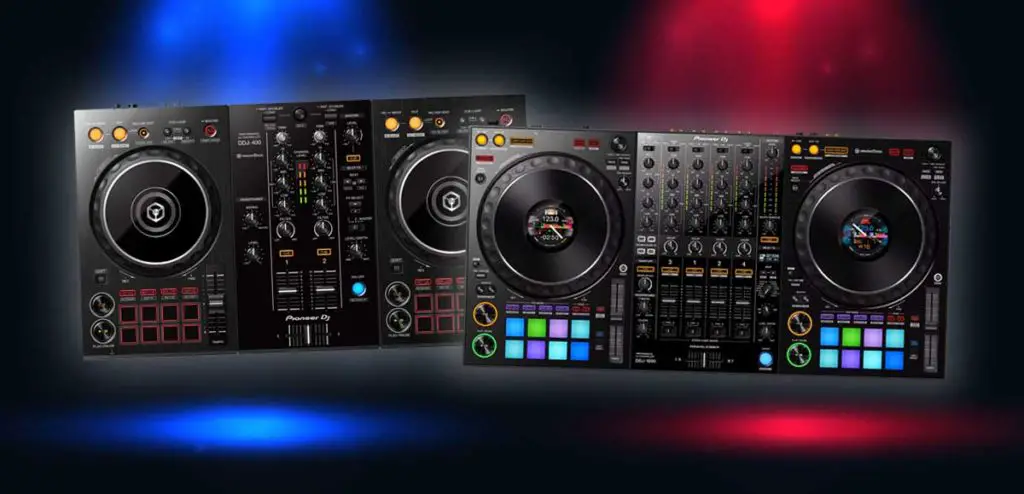
In general you can draw a line between so called entry-level DJ controllers (mostly smaller in size, featuring only 2 mixer channels and having limited additional functionality) and “professional” DJ controllers (usually having 4 mixer channels, being larger in size, more durable and having more additional features on board).
If you’re a beginner DJ you can either go with a usually cheaper entry-level DJ controller to check and see if DJing is a thing for you (like the Pioneer DDJ-FLX4), or get yourself a slightly pricier full-fledged professional controller that has a chance of lasting you a longer time and enable you to use a wider range of features (like the Pioneer DDJ-1000).
During your search you may also come across older DJ controllers (for example back from early 2010’s) that are no longer supported or simply no longer updated by their manufacturers (like the original Pioneer DDJ-SX). Those are generally fine if you’re just starting out, but again they may be lacking both in terms of official support and the features, as the DJ equipment business is rapidly evolving through the recent years.
Pioneer DDJ-FLX4 – One of the best choices this year
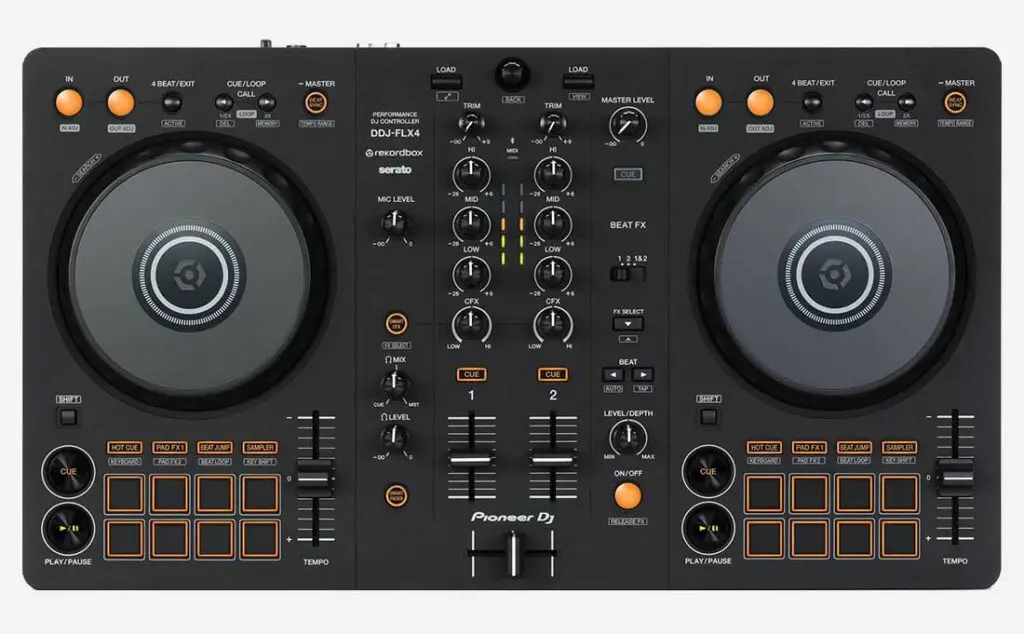
Without a doubt, whenever you’ll ask us about the most popular entry-level DJ controller for beginners this year, you will get one and the same answer: the Pioneer DDJ-FLX4 which has officially replaced the DDJ-400 after its discontinuation in late 2022.
This dedicated Rekordbox & Serato DJ controller is definitely one of our first choices when it comes to DJ gear for beginners after the 400 has started leaving the market. Not only is it simple to use, but also it has many of the functions that the pricier DJ controllers have, two exclusive features not found anywhere else (Smart CFX and Smart Fader) and it features the classic club control layout resembling a 2xCDJ setup with a Pioneer DJM mixer.
Pioneer DDJ-FLX4 vs. DDJ-Rev1 (Which One Is Better?)
If you’re just starting out, we deem it one of the best and most common first choices that you can make. While it’s still an entry-level controller, it certainly doesn’t feel like a toy during your day-to-day usage which can be a problem with some of the cheaper devices meant for beginners.
Pioneer DDJ-Rev1 – A good choice for Serato DJ users?
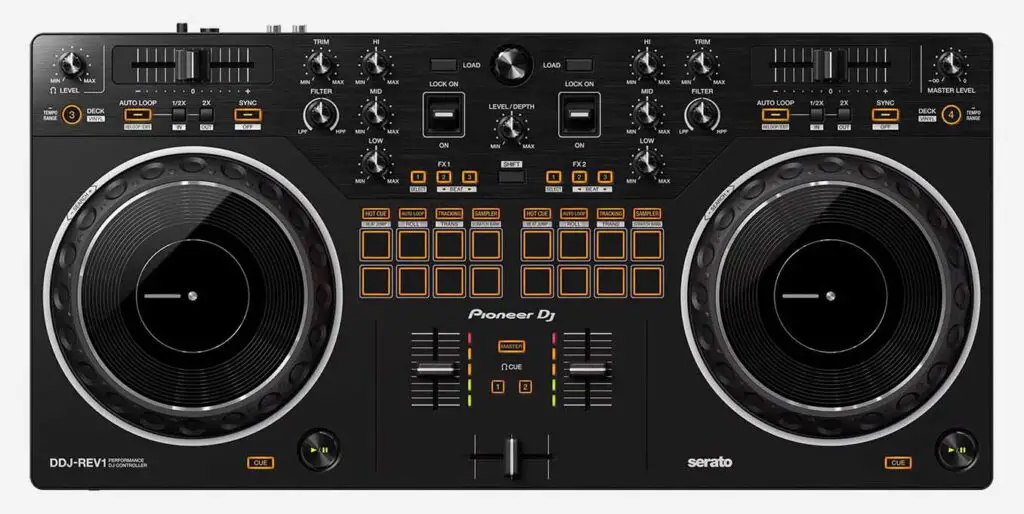
It would be smart to say that the Pioneer DDJ-Rev1 is kind of like a DDJ-FLX4 geared towards beginner scratch DJs and Serato DJ users.
An important thing to mention is that the DDJ-Rev1 works with Serato DJ Lite out of the box, and to make full use of this controller (make use of all the functions accessible from the device) you have to upgrade to Serato DJ Pro (which is available as a one time buy or a monthly subscription). Unfortunately, this controller doesn’t support Rekordbox DJ software at all.
If you’re just starting out, the general software choice is pretty much arbitrary, as both Rekordbox and Serato DJ are currently two of the most popular DJ software and the differences between them while important for experienced DJs that are used to one or the other, don’t really matter much for beginners and intermediate users.
One thing you should definitely know though, is that the Serato DJ Lite software version which both the FLX4 and the Rev1 come with by default, is really limited in terms of its actual feature set. It’s highly unadvisable to use any of these devices with the Lite version for anything other than light practice.
You can learn much more about the Serato DJ Lite and Pro differences here: Serato DJ Lite vs. Pro (12 Most Important Differences)
If you want a detailed comparison between the FLX4 and the Rev1, we’ve also got you covered: Pioneer DDJ-FLX4 vs. DDJ-Rev1 (Which One Is Better?)
DDJ-SR2 – A small SX-like powerhouse
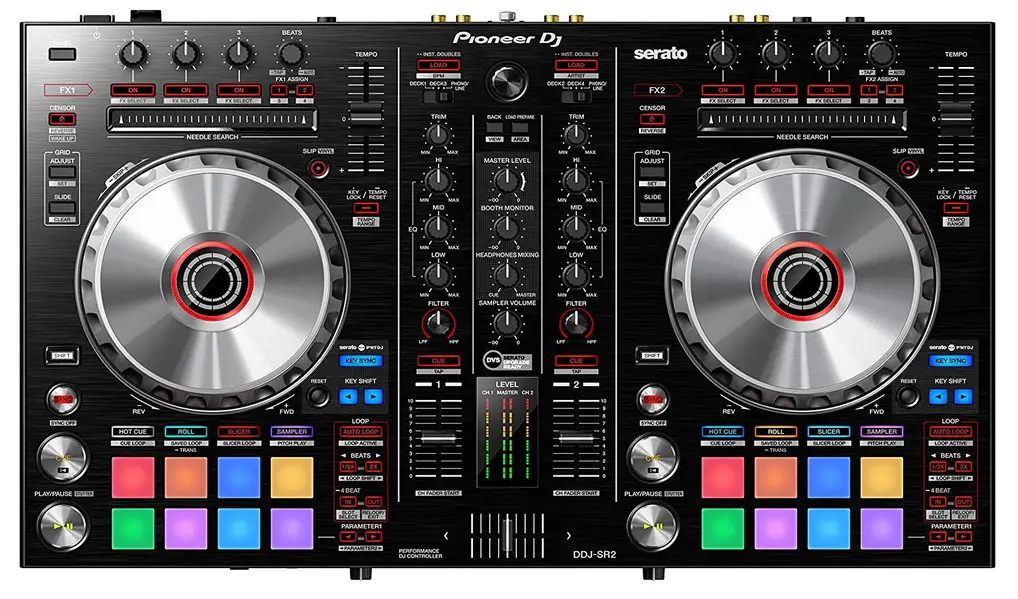
Pioneer DDJ-SR2 is also a dedicated Serato DJ controller. This little device while being only a 2-channel controller has a lot of useful features packed into it. In fact, it’s sometimes compared to the DDJ-SX series, as the button layout and features present on the device closely resemble those of the DDJ-SX3 and its predecessors.
Compared to two controllers mentioned before the DDJ-SR2 is a bit more feature-rich but also comes at a slightly higher price point. Definitely consider that one at the beginning of your DJing journey!
As the DDJ-SR2 has already been discontinued by Pioneer DJ and is not likely to appear in their official Amazon store again, you might have better luck looking for a used one, for example over on Ebay.
2 mixer channels vs. 4 mixer channels debate
Having two mixer channel essentially enables you to have two tracks playing at the same time. This is the absolute minimum for a DJ to perform a basic transition between two different songs.
Some DJ controllers featuring only 2 mixer channels, have additional deck changing buttons which you can use to switch all available controls to control virtual decks 3 and 4 (this is the case with the previously mentioned DDJ-Rev1).
This isn’t really an ideal solution, as there really is no efficient way to mix 4 tracks using a 2 channel mixer, and the mixer fader positions often get mixed up when rapidly switching between decks 1/2 and 3/4 (switching between the deck pairs naturally doesn’t reset the physical position of the fader).
4 channel controllers are in general more pricey than 2 channel controllers. There is however one interesting cost-effective entry-level controller that features 4 mixer channels – that is the DDJ-FLX6 which we have already done an in-depth write-up on.
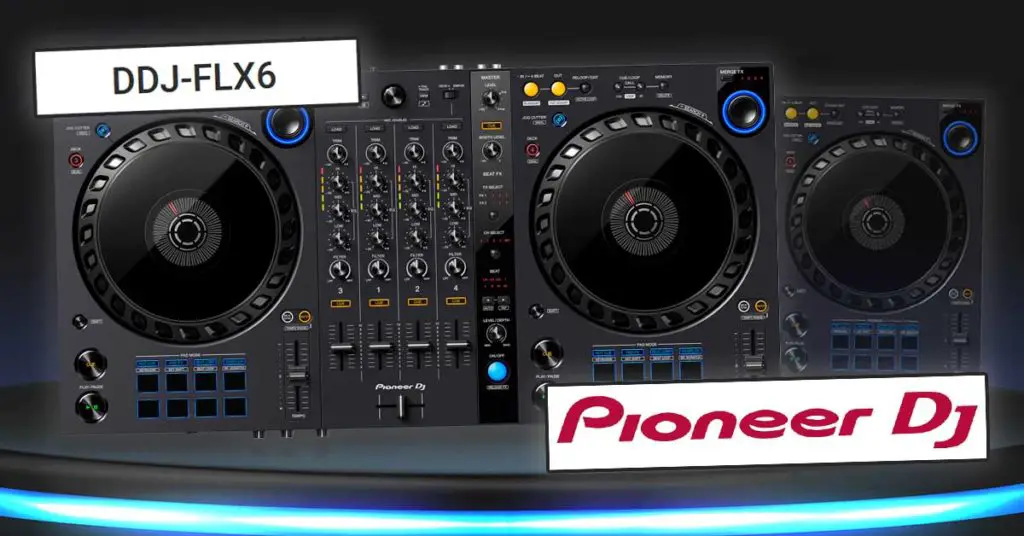
Having access to 4 mixer channels, you are able to simultaneously play up to 4 different tracks. Of course you won’t be using this functionality all the time, especially if you’re just starting out.
Multi-channel mixes or mashups can generally get pretty complicated and as a beginner you shouldn’t stress too much about these.
In many 4-channel devices you can also assign the channels 3 and 4 to the sampler or the microphone output and for example use audio effects on those inputs. This of course depends on the DJ controller of your choice, as different DJ controllers have different internal audio routing options.
Additional mixer channels can also give you the opportunity to utilize other input devices such as CD players, turntables and more. This however works only if your controller’s mixer has appropriate additional audio inputs for this purpose.
Some higher-end DJ controller mixer sections can function in a standalone mode (they can work as a regular audio mixer utilizing its audio inputs and outputs when the controller isn’t connected to a computer).
Most of the entry-level controller mixers won’t have additional outputs and inputs and will only allow you to control the audio coming directly from your DJ software.
DJ controllers with standalone audio mixers built in will generally be above the average price point of entry-level DJ gear.
Moving towards more advanced gear
It’s a common thing to move on to more advanced DJ gear when you outgrow your entry-level controller after learning the basics of DJing. You can also start off with a slightly more expensive DJ controller that will allow you to skip the upgrade process entirely.
As per many online testimonies, most people that don’t lose interest in this wonderful hobby that is DJing, outgrow their first entry-level DJ controller in less than a year.
If you’re set on your goals we believe that jumping straight into a higher end DJ controller can actually be very beneficial for you (we of course still suggest the Pioneer DDJ-1000 if you prefer to go all-in right from the beginning).
The great thing about this, is that although DJ controllers like the DDJ-1000 can look quite intimidating, they are in fact just as simple to use as the entry-level gear.
If you’re really into DJing, and you’re set on pursuing DJing as career or as a hobby, you can’t go wrong with jumping straight into the world of professional DJ controllers.
Below we list two most popular units that pretty much are current Pioneer DJ flagships in terms of non-standalone DJ controllers.
Pioneer DDJ-1000 – the flagship

The Pioneer DDJ-1000 is now pretty much a flagship Pioneer DJ controller. While the price point may be pretty steep for some, you can’t really get more than this for now in terms of standard non-standalone DJ controllers.
DDJ-1000 comes both in dedicated Rekordbox variant (regular DDJ-1000) and Serato DJ compatible version (the DDJ-1000SRT).
The DDJ-1000 both in terms of layout and present features closely resembles the CDJ-2000NXS line of flagship Pioneer CD players, alongside with DJM mixers. This is definitely the best choice and if you’ve got the money and you’re set on getting the best DJ controller from this list, in our humble opinion this is the one!
Pioneer DDJ-SX3 – the Serato beast
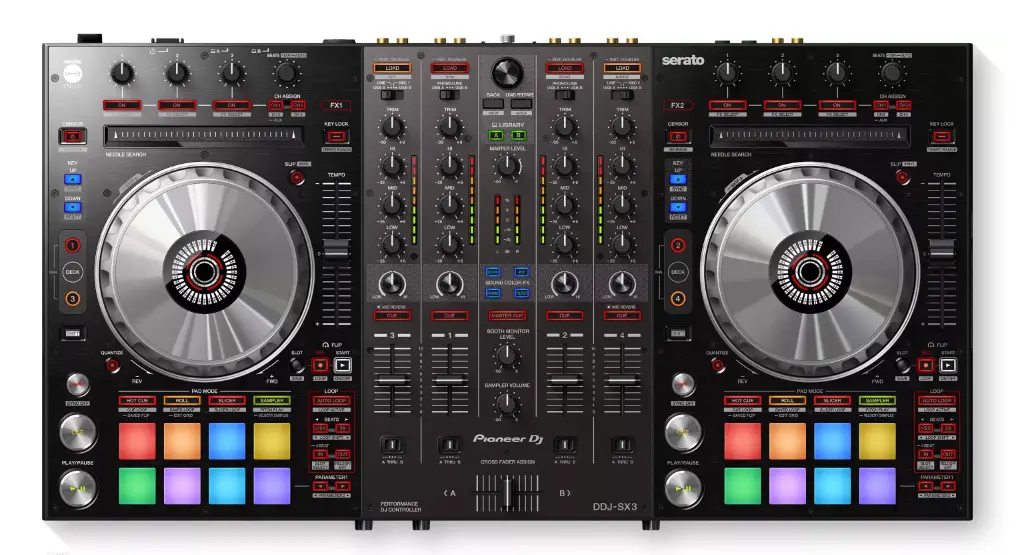
In a sense the only direct competitor of the Pioneer DDJ-1000 (excluding the standalone Pioneer XDJ-XZ) is the Pioneer DDJ-SX3.
Pioneer DDJ-SX3 is a dedicated Serato DJ controller that is a latest controller from the SX series that has persisted on the market for over a decade long.
Again, this 4-channel DJ controller is made with Serato DJ software in mind, so both the button layout and device’s functionalities will be geared towards Serato DJ software features.
Nevertheless this is a great pro-level device that takes one of the top places in the consumer market since its release in 2018. You should definitely check it out!
Last things last
You have to remember, that while your DJ controller and your laptop are the core parts of your DJ equipment setup, you still need things like headphones or monitor speakers, PA system and all the required audio cables.
It’s easy to omit both costs and importance of these seemingly less needed things so make sure that you think ahead!

